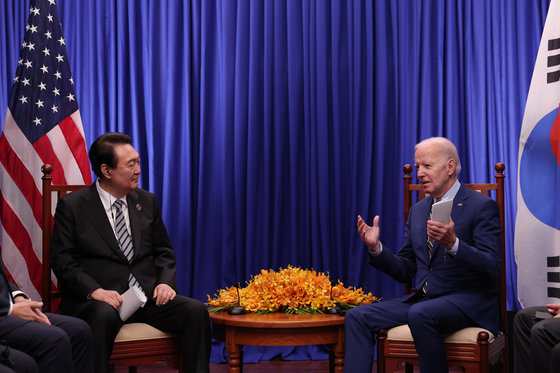It is known that South Korea and the United States are discussing ways to stipulate in a special document a plan to strengthen a practical ‘extended deterrence’ (nuclear umbrella) equivalent to ‘Korean-style nuclear sharing’ at the summit between President Yoon Seok-yeol and US President Joe Biden. With President Yoon’s state visit to the U.S. as an opportunity, attention is focusing on whether the security alliance between the U.S. and South Korea can achieve forward-looking development.
According to the President’s office on the 24th, the two governments will effectively and concretely strengthen US expansion deterrence through a joint document adopted by the two leaders after President Yoon’s state visit to the US and the summit meeting on the 26th to mark the 70th anniversary of the ROK-US alliance. It’s under discussion.
A typical example is the US providing a ‘Korean nuclear umbrella’. Specifically, it is said that the governments of both sides are reviewing a plan to include in a document that the United States will respond with nuclear weapons in the event of a nuclear attack on South Korean territory.
Extended deterrence, also known as the nuclear umbrella, is a concept in which the United States operates a nuclear umbrella or missile defense system to provide deterrence comparable to that of the US mainland if South Korea is under a nuclear threat. So far, South Korea and the U.S. have remained at the level of confirming the principle of extended deterrence at the principle level through a joint statement.
 President Yoon Seok-yeol and US President Joe Biden are holding a Korea-US summit at a hotel in Phnom Penh, Cambodia on November 13 last year (local time). 2022.11.14 Provided by the Presidential Office
President Yoon Seok-yeol and US President Joe Biden are holding a Korea-US summit at a hotel in Phnom Penh, Cambodia on November 13 last year (local time). 2022.11.14 Provided by the Presidential OfficeHowever, if President Yoon and President Biden reach an agreement on “strengthening extended deterrence” at the summit and confirm this text, the US promise of nuclear retaliation will be specified for the first time in an official document between Korea and the US. In this case, it is expected that the prospective development of the ‘security alliance’, which is one of the three themes (security alliance, value alliance, and technology alliance) of the state visit to the United States, will be achieved.
Since its inauguration, the Yoon Seok-yeol administration has been discussing ways to strengthen US extended deterrence through the High-Level Extended Deterrence Strategy Consultative Group (EDSCG). In particular, President Yoon has stated in multiple interviews that he is discussing plans for joint planning and joint execution of US nuclear asset management.
A high-ranking official in the presidential office told News 1 that while revealing the principled position that “the situation under negotiation cannot be confirmed,” he said, “However, we are discussing ways to effectively and concretely strengthen extended deterrence (provided by the United States).” said.
Another key official said, “In principle, it would be good if (the Korean nuclear umbrella) was adopted as an official document, and it is what our people want,” adding, “However, the actual decision is a homework that must be resolved by the leaders of the United States and South Korea.”
It is said that South Korea and the U.S. are also discussing plans to deploy U.S. nuclear forces around the Korean Peninsula at a permanent level and to have South Korea participate in nuclear operations from the planning stage and expand ROK-US joint exercises. It is also known that the establishment of a permanent consultative body between the two countries to discuss nuclear operation is also under discussion.
President Biden will also promise practical measures to emphasize the United States’ commitment to deter North Korea’s nuclear attack on South Korea at a summit with President Yoon, Reuters quoted a senior US official on the 21st (local time). ) reported.
This official said, “The United States has emphasized that the commitment to deter North Korean nuclear expansion toward South Korea is very clear.” I will make it clear that there is no doubt that I will do it.”
Source: Donga
Mark Jones is a world traveler and journalist for News Rebeat. With a curious mind and a love of adventure, Mark brings a unique perspective to the latest global events and provides in-depth and thought-provoking coverage of the world at large.